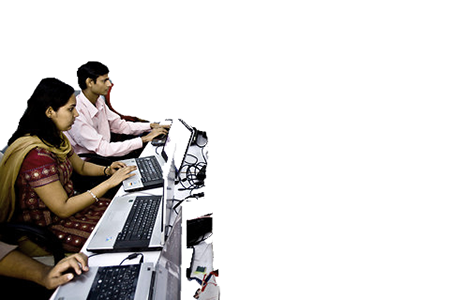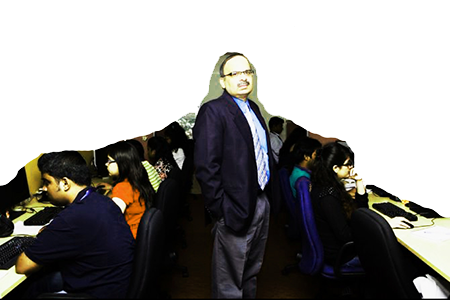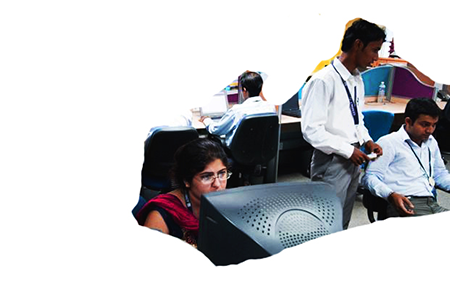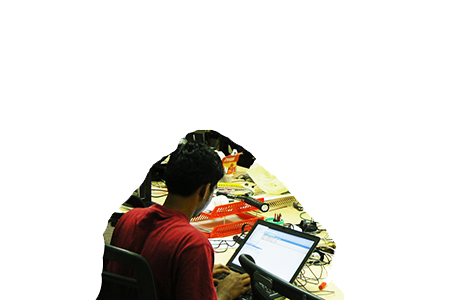Work in the Indian IT field: freedom or slavery?

The globalization of the labor market in a new way raised the questions of the choice of workers. In pursuit of the cheapest possible labor force, US and European companies turned to Indian (Chinese, Russian, Ukrainian) information producers. The “demand” for Indian specialists turned both the internal structure of the labor market and the education system.
The changes that occurred in India in the 2000s are called the “Indian IT revolution”. The “revolution” was accompanied by a rapid growth in the number of specialists employed in the IT industry (making up today about a quarter of the total mass of workers) and multiplying the total contribution of the industry to the national GDP. As a result, by the end of the 2000s, a situation had arisen in which a huge part of the Indian population, taking a job at an office in Chennai or entering the local Silicon Valley of Bangalore, actually does work for San Francisco customers or, for example, New York.
')
How and at the expense of whom carried out so rapid growth? In what conditions do the specialists of the “future” / non-material workers of the beginning of the century work? Below, I will give some testimonies of those who experience “happy changes” on a daily basis and those who are trying to invent ways to collectively intervene in a situation. That is, evidence of the scale of distribution of literally suicidal labor conditions in the software industry in India, as well as evidence of attempts to create professional self-organizations of workers.
Informational labor and outrage
One of the opinions about current events in India was published in March 2013 by K. Kahn, an IT worker at a software development company in Bangalore, a member of the Indian Association of IT Employees (ALLITEA), a member of protests organized by HCL employees.
“The neoliberal regimes in India, in several states including Central, regardless of the ideological position of the party in power, quickly created the artificial islands of Knowledge workers. Including in order to separate them from other groups of workers involved in the struggle for their rights and interests. The recent protests of HCL workers, which unfolded in front of the HCL offices in various parts of the country, have shown: the number of IT sector in India is increasing. Unfortunately, up to this point the workers themselves did not attempt to collectively voice their voices, to declare exploitation in this area. The protests of HCL employees are only the tip of the iceberg, showing an increase in outrage among IT companies' employees, their irritation, intimidation, exploitation, etc. In a situation of deep global economic crisis, IT workers felt the pressure from so adored bosses, who now showed their “true” faces.
The question that does not leave me alone is: Why did it happen that in India there have not yet been any attempts to create a trade union association or an association of employees of private companies, not only in the field of IT, but also any white-collar associations in a principle
One of the answers to this question, shared by many, is considered the fact that the private sector of “white collar workers” is well paid and organizations take great care of their employees. But the truth is that, at least in the IT sector, companies “donate” their employees because of their own fear (of the government). The IT sector is a significant resource of national GDP. No company wants to risk, that is, adversely affect the growth of the industry (in the case, for example, of workers' strikes).
A few months ago, the news spread around the media. Chairman of the Ministry of Labor of the Government of Karnataka recommended stopping the artificial inflation of IT growth, stop providing benefits to IT companies. However, after a brief discussion in the news, the IT industry continued to stretch again.
A study conducted by NIMHANS in Bangalore provided shocking data: more than 36% of technicians experience severe mental disorders. 1 out of 20 IT professionals seriously think about the possibility of suicide, reports NIMHANS. 27.6% of IT workers are addicted to various drugs. Suicide, health problems, conflicts in the family due to the strongest pressure at work and long unregulated working days seriously distort both relationships with close people and the social fabric of society as a whole. The expression “burned out at work” has become popular among the IT industry workers, as well as among staff officers, who have not ceased to intensify their efforts to find new ways to motivate and raise the competitive spirit of 14-18 hours of daily work in an office in the IT industry is considered the perfect norm. This figure can be easily verified by anyone who doubts or denies such a fact.
Anyone can find and read a lot of suicide stories in the news. In some cases, the employee who committed suicide, leaves a note in which he accuses his manager, the head of his act. And so far nothing has been done by the government to stop the destruction of society.
A few months ago, the headlines of all major newspapers announced the government’s proposal to introduce biometric passports for all IT professionals. This idea was supported by company executives. If it is not slavery, then what is it?
The only way out - the union. But it is important to understand that in the existing conditions, not all workers are able to join a trade union or association, to collectively oppose exploitation and intimidation. Most of the workers are afraid of immediate dismissal.
Nevertheless, there were those who nevertheless initiated the registration of the association of IT specialists - All India IT Employee Association (for more information on the objectives and goals of the association, please visit their website ). Among the main requirements of AllTEA are: to draw the government’s attention to the need to create a pension program for IT workers, to provide employees with complete information about companies in the industry (by publishing it on the official website of the association), about the working conditions in it (not just the level of salaries, but also the level of satisfaction workers, conflicts, irritability). We aim to develop a list of rules and requirements for working with employees, designed to protect and preserve the interests of employees. This list, approved by government services, will clearly define what is allowed and prohibited within the company. ”
The total number of members of the association that declared itself the first independent trade union association in the field of IT in India, today is about 10,000 people. The main objectives of the association are the adoption of an IT act and the provision of social guarantees for all IT specialists (insurance, bonuses, processing fees, etc.). Along with another association, the IT and ITES Workers Union (UNITES), this association represents a successful attempt at self-organization. "Specialists of the XXI century" in India.
Illusions, rivalry and suicide
What still does not suit the members of professional associations? What they are not able to cope with their own individual forces? And why are IT workers so exposed to the illusion of their own exclusivity?
The answers to these questions are partially complemented and prompted by the text of another IT worker Gautam. The dismissed employee focuses much more attention on the relationship between managers and subordinates. His text offers a critical analysis of the illusions of the IT revolution and the corporate system of large modern IT companies. That system which on check appears no more than disguised mechanism of operation.
“The fact that the IT revolution in India has made it really real is the spread of a false perception of oneself as the most worthy, great, talented employee among IT specialists. In India, in particular, due to the reforms of Manmohan Singh, the number of IT employees has always exceeded the number required by the market. This discrepancy affected salaries that remained small.
What are the structural changes that made this well-performing money machine (the outsourcing industry) possible? The key figure of this machine is the figure of the manager. The development of capitalism over the past couple of decades has been accompanied and supported by the development of new theories of scientific management. The work of the manager directly affects the well-being of the company and depends on it, whereas the payment for the work of ordinary employees who produce “informational” products has nothing to do with the actual level of profit received by the company. A mid-level manager works well if each of his subordinates is 100% or more productive. Workers face each other, engaging in continuous struggle, competition for their own individual well-being. There is no sense of belonging to a single team, empathy, solidarity. All participants in the race are irreconcilable rivals. The internal ideology of the company is based on extreme individualism, around personal success. There are also managers who are behind middle managers, driving them and pushing them. The entire system of power within the company looks as if it is a series of incessant struggles for survival.
Speech managers involves the use of a special dictionary. Thus, the individual usually acts as a simple “resource” for the manager, replaceable and completely impersonal. People should appreciate and pay for the opportunity to work hard as an IT specialist. Employees must respect the “values” of their own generous companies.
In India, the majority of incoming outsourced orders are quite elementary and do not require high IQ or special skills. A standard IT worker needs to be submissive, able to obey, any individual impulse to independence and creativity is quickly suppressed. The training of a newcomer, a young, inexperienced specialist turns out to be one of the key steps in processing a person into that which best suits the company's needs. This training includes language, gestures, work posture, mode and methods of nutrition, recreation, etc. That is, a full course on polishing the fighter for the future prosperity of the company (its superiors). Such an initial investing in a newbie is vital for Indian companies. For IT vacancies in India, an employee is expected to meet only two basic requirements: knowledge of English and secondary academic achievement. This is the notion of a novice programmer.
Ideas about the privileges of IT workers are extremely exaggerated. They are difficult to call those who produce knowledge. IT workers in most cases simply repeat the same operations, tasks, applying all the existing forces and often being under the illusion that their work is amazing and free. They are trying to reject the fact of their own absolute substitutability and the fact that there are thousands of others awaiting their turn for this replacement.
Due to the fragility of the situation, any public act of dissatisfaction ends for an employee with immediate dismissal. There are thousands of ways and a way to dismiss an employee, and getting rid of the “arrogant” employee is not a problem at all. Moreover, the dismissed employee immediately turns into a subject of corporate policy, turning out to be a negative example for every “good” creative IT-specialist. The current situation in the global information supply market does not allow us to hope for an increase in wages in the IT industry in India, which receives most of the orders from America on the basis of the outsourcing model. What is the reason why the myth of own exclusivity and confidence in the future is so firmly rooted in the heads of IT workers today? What can wake them up? Questions that are not answered .
The so-called “Knowledge Based” job charms with higher wages (compared to the average wage level in India). But the exploitation here is hidden behind the carefully thought-out names of “flexibility”, “opportunities” and “chances”. “Diligence” of a manager and / or employee seeking to outrun rivals and save a workplace, in India often, as already noted, ends in death (suicide or heart attack). For example, this is the typical story of one of the many deaths that occurred at work and / or because of work:
“Bharat was an honest, hard worker, with a wonderful family. But his honesty turned out to be a huge weakness, which employers have successfully exploited. Bharat worked for one of the major Indian companies, which, like all IT companies, promised its employees special advantages: high salaries and the opportunity to work abroad. “Special” advantages forced workers to work around the clock: they were afraid to be dismissed and hoped to get a promotion, a business trip abroad. On one of the weekends, driven by managers, Bharat worked continuously for three days until his heart stopped due to a heart attack. This case was presented as an incident committed due to personal disregard for own health, as well as personal greed (in pursuit of extra money).
In this situation, it is impossible to prove the guilt of an individual manager, since this type of behavior is “inspired” by the entire corporate ideology. Employees do not have the ability and time to merge, design their own union. They work during the day and night, producing products in accordance with the terms given by the managers. While the employee is paid a little higher than the cost of renting a tiny apartment, the management removes the “cream”, having an income several times higher than the developer’s salary . ”
***

So, back to the question voiced in the title of the article: Who are the IT workers in India today? What are they? The image of a free, independent, creative worker, providing humanity with new knowledge, developing new progressive technologies, seems too far from the portrait of an IT specialist who offers us the reality of the global market of the 2000-2010s. Work in the field of IT is becoming increasingly similar to the work of monotonous repetition of the same operations, tasks, requirements. Works that exclude that “free flight of thought” and the uncontrolled production of knowledge that theorists of cognitive capitalism so often talk about.
Armed with the myth of their own "bright personality" and / or fearing losing an "enviable" workplace, IT professionals are in constant tension: they need to simultaneously manage to complete a work task and maintain their own knowledge and skills "in tone", continuously monitoring technological changes. As a result, work activity becomes difficult to separate from rest and crowds out all other spheres of life. The lifestyle of an IT worker, private night work (largely due to the difference in time zones between countries) makes normal communication and support of relatives, friends, and colleagues, impossible. Weekends are usually used to finally sleep (or work) and often take place alone. Having come to work on Monday, the person again appears in a role of easily replaceable resource of the company.
Long and scattered working hours, constant unpaid processing, emotional exhaustion - this is the shortest list of problems in the IT industry in India (and in other countries). Problems that should be publicly and collectively raised, and not hushed up in the dense walls of personal depression, fear and irritation.
A.Kalk, for the IT Trade Union .
The article was prepared on the basis of www.thehindu.com , www.deccanherald.com , www.ciol.com . Texts of Indian workers are translations of published author articles.
Source: https://habr.com/ru/post/219373/
All Articles




